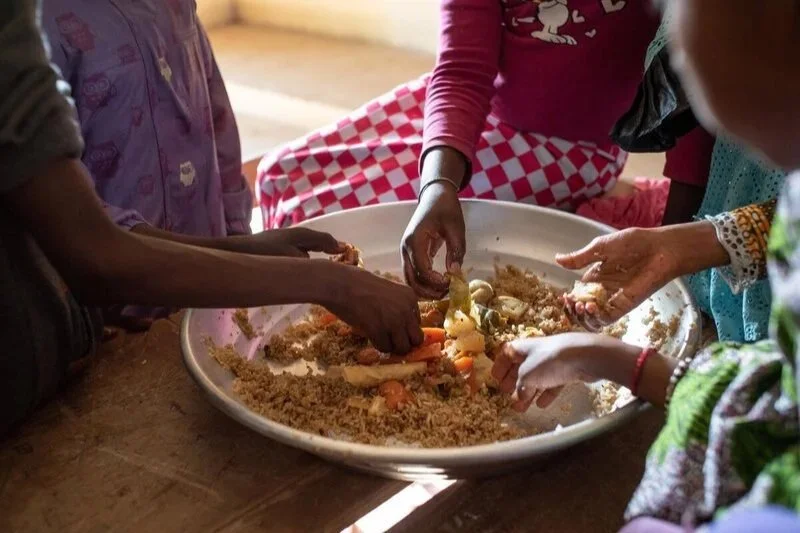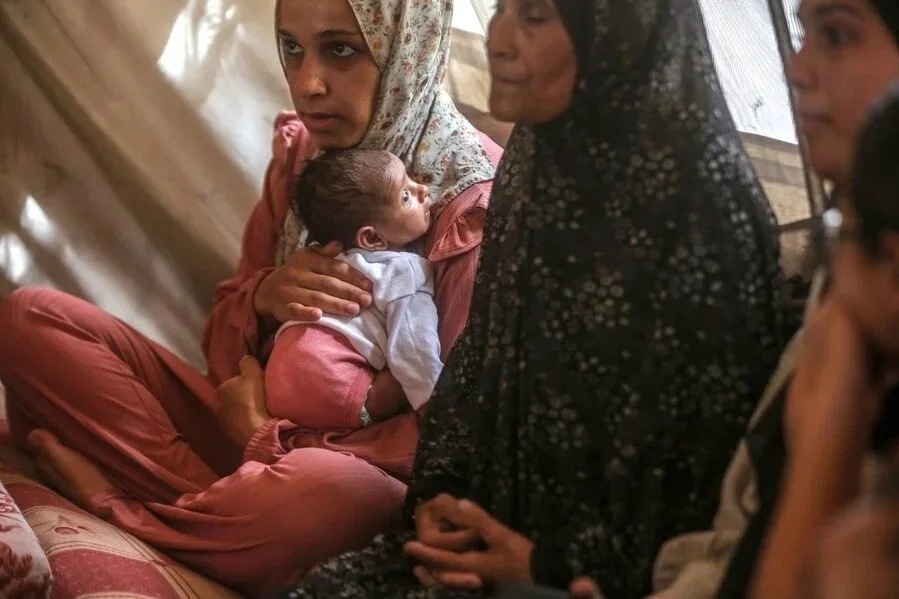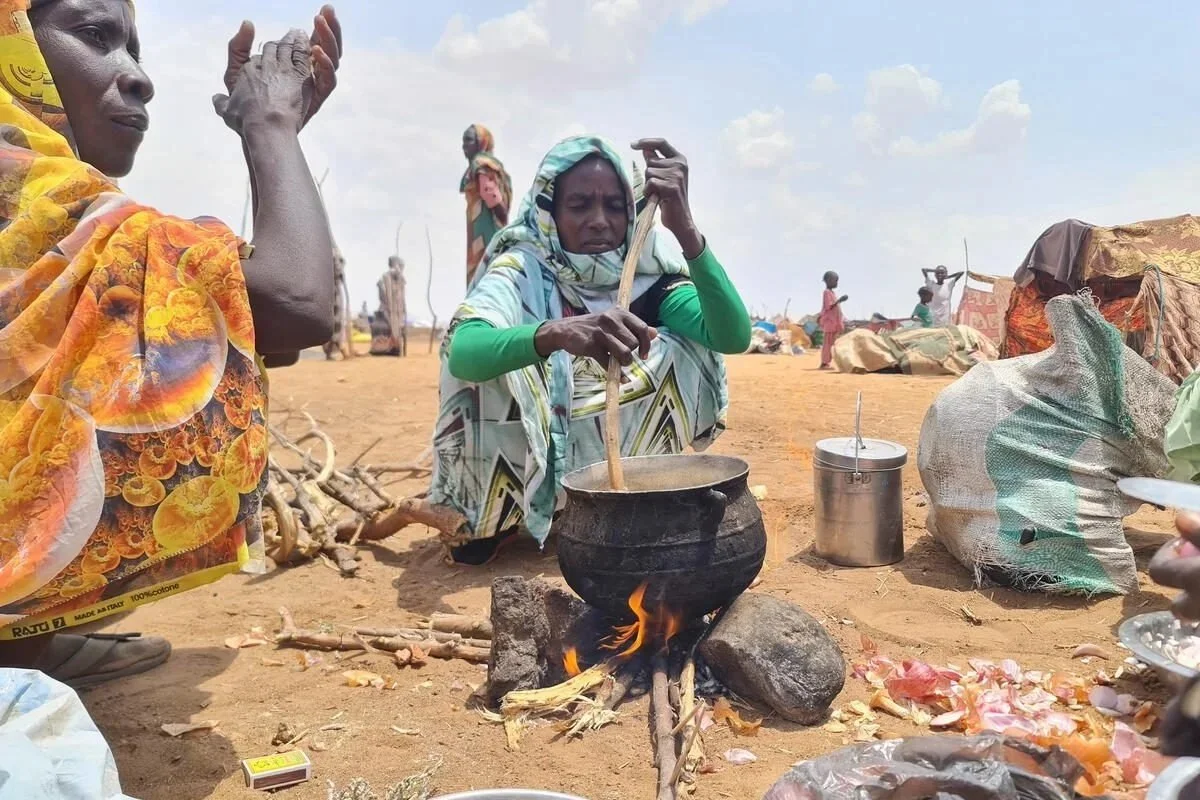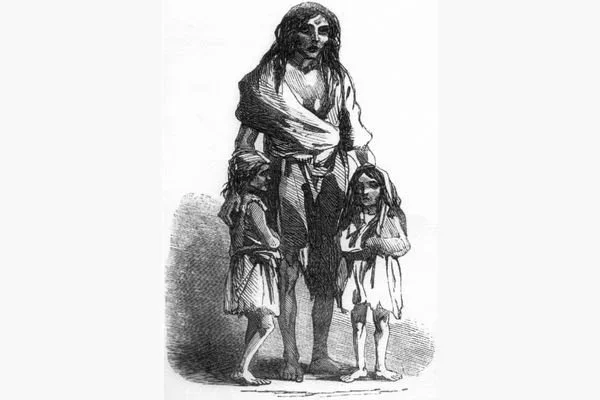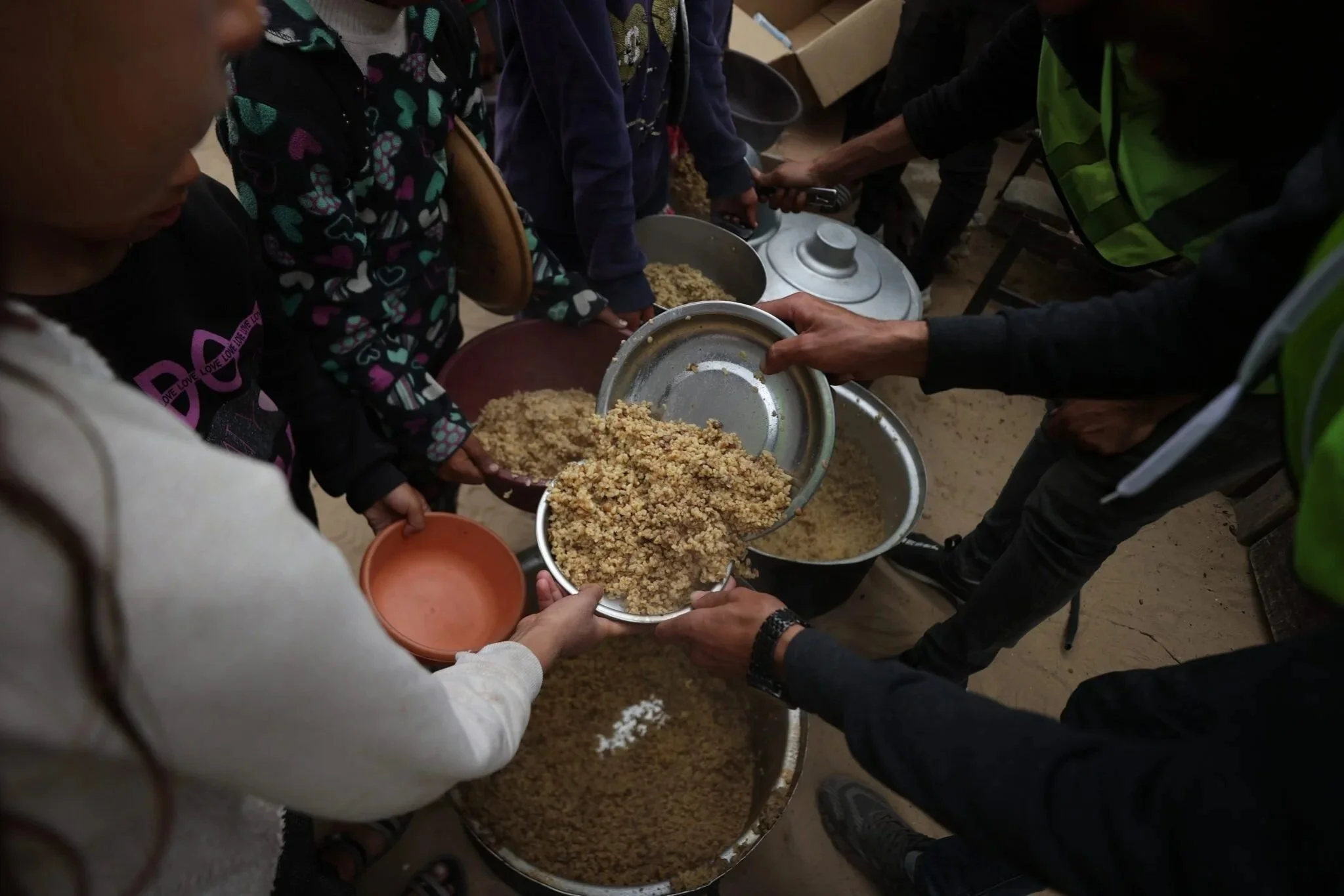Starvation as Strategy: How Empire Weaponizes Hunger for Power
For centuries, starvation has been wielded as a strategic and brutally effective tool of colonial and imperial violence. What’s happening in Palestine, Sudan, the Congo, and elsewhere is nothing new. It’s the latest chapter in an old and devastating playbook.
Food security is a moral imperative while also increasing stability across the world — but millions of people are still going hungry. (Photo by WFP/Jean-Baptiste Joire)
History isn’t repeating. It’s refining. Those in power study the past not to prevent its horrors, but to perfect them. Each generation escalates the barbarity, going from war criminals masquerading as explorers and conquerors to now cosplaying as world leaders and politicians. The mainstream media and its journalists, all complicit by choice, launders these crimes as justified actions by spreading blatant lies and propaganda even in the face of irrefutable evidence.
Genocide is empire’s ultimate atrocity, and we are watching several unfold in real time on our screens. Genocide — by any means — repeats when the world refuses to learn and chooses instead to destroy human, animal, and ecological life with calculated cruelty. As part of its strategy, empire manufactures famine — state-sanctioned starvation framed as one of the unfortunate “consequences of war,” when it is in fact an internationally recognized crime enforced through siege, theft, and the denial of life’s most basic needs. Rationing has often served as the precursor. This calculated restriction of food is marketed as a form of aid — a way to package subjugation as benevolence — but in reality it clears the path to starvation.
Today, food rations are being slashed worldwide as hunger continues to rise. While the crises in places like Palestine, Sudan, and the Congo have been catastrophic for too long, events of late have driven starvation to urgent levels. Nearly 300 million people worldwide depend on humanitarian aid, yet drastic cuts have been made to funding — and as military spending continues to soar. The U.S. was the world’s largest aid donor until recently, contributing 30 percent toward the global aid budget and 43 percent of worldwide humanitarian needs. Earlier this year, the U.S. Department of State terminated more than 10,000 foreign aid grants and contracts, which gutted lifelines like nutrition centers that keep malnourished children alive, maternal health services, and cash assistance for essential items.
Everything connects. To understand and respond to what is happening now, we must remember what came before. We begin by examining the effects of starvation on human beings. From there, we map its reach across Palestine, Sudan, and the Congo, before looking back at some historical famines and genocides that paved the way for these current atrocities. Moving through the forced starvation of Indigenous peoples in North America to the ships that carried food out of a hungry Ireland, to the grain hoarded during the Bengal Famine, the patterns are undeniable. The systems of empire and the starvation it uses as a tactic are not new. Only now, we collectively have the power to stop them, both for the present and for future generations.
THE IMPACT OF STARVATION
Many of Sudan's war displaced crossing into Chad carry burdens of hunger and trauma. (Photo by WFP/Djaounsede Madjiangar)
The world produces more than enough food to feed the global population, yet over 3 million children die from hunger each year. Starvation is among the most deliberate and degrading ways to kill, dismantling a human being from the inside out to prolong suffering. It often begins with undernourishment, when the body’s energy needs are not met, progressing to malnutrition, and eventually to starvation. As days pass without food, the body exhausts its carbohydrate and fat stores, then begins breaking down muscle and organ tissue for energy. Metabolism slows, temperature regulation falters, kidney function declines, and the immune system weakens, leaving the body unable to fight infection or heal from injury. In the final stages, the body cannibalizes itself, consuming its own tissues — including the heart muscle — before death gets painfully drawn out over days or weeks.
When starvation takes hold, the signs are unmistakable. Fatigue, poor concentration, low mood, and depression are common. In children, it can also cause behavioral changes such as irritability, slowed movement, or anxiety. For survivors, starvation steals from the future, leaving lasting damage to brain function, cardiovascular health, and immune strength. Malnutrition in early development — especially in utero — increases the risk of heart disease, diabetes, and cognitive impairments for life. Even children who appear to recover may carry silent damage in their gut, immune system, and brain for years. Inflammation can persist nearly a year after severe acute malnutrition.
Delivering food to affected areas must be done with care. A sudden return to normal meals can trigger refeeding syndrome, where dangerous electrolyte shifts can damage the muscles, lungs, heart, and brain. Therapeutic feeding is one of the most effective interventions. Ready-to-use therapeutic food (RUTF) — a calorie-dense paste of peanuts, milk powder, butter, oil, sugar, and a blend of vitamins and minerals — enables safe, rapid weight gain. It can be eaten directly from the packet, requires no preparation, and has a two-year shelf life.
PALESTINE’S ENGINEERED STARVATION
A family displaced multiple times from Jabalia and currently living in a tent. Almost a third of families are missing meals for days at a time in Gaza. (Photo by WFP/Ali Jadallah)
Across Palestine, starvation is accelerating. Since March 2, 2025, nearly all access to food, fuel, clean water, and medical aid has been cut off. Supplies are sitting at border crossings, deliberately withheld by Israeli forces funded and protected by the United States. As a result, Gaza has reached the Integrated Food Security Phase Classification (IPC) Phase 5 famine conditions, the most catastrophic level on the IPC scale. This designation requires that at least 20 percent of households face extreme food shortages, 30 percent of children suffer acute malnutrition, and two of every 10,000 people die each day from starvation or its complications. Gaza has surpassed all of these thresholds, but a formal famine declaration has not been issued yet because mortality data cannot be verified in a place where hospitals are bombed, health systems have collapsed, and journalists who document the truth are murdered.
This famine in Gaza is a deliberate policy enforced by the United States, Israel, and their allies. Palestinians have endured relentless bombardment, mass displacement, and total siege since October 7, 2023. Civilians are shot and bombed while trying to secure food and water. Medical workers and journalists are often being targeted and killed, or they are collapsing from hunger. Children tell their parents they want to go to heaven because “heaven has food.” Aid convoys have been attacked or blocked. Civilian aid ships and their crews have been seized by Israeli forces in international waters. On land, Egyptians have tossed bottles filled with food staples into the Mediterranean in a desperation bid to reach Gaza. Brief “humanitarian pauses” serve as public relations while allowing in only a minuscule fraction of the awaiting aid needed to sustain life in Gaza. The scale of devastation has only increased with time. And still, despite the growing chorus of global protests and acts of resistance against this genocide, this siege endures.
Even before this genocide, over 80 percent of Gaza’s population relied on humanitarian assistance — the result of an Israeli-led blockade that has, since 2007, tightly controlled all air, land, and sea routes. Imposed after Hamas won the election and took control of Gaza in 2006, the blockade has long restricted access to food, fuel, medical supplies, building materials, and more. It has also severely limited social, work, and educational opportunities as well as medical care. This has effectively turned Gaza into what many human rights observers call an “open-air prison.”
In 2012, following a Freedom of Information petition by the Israeli human rights group Gisha, Israel’s Ministry of Defense was ordered to release internal documents revealing that, between 2007 and 2010, officials used a calorie-based formula to determine the minimum amount of food allowed into Gaza to avoid outright malnutrition as part of their broader policy of restricting goods under the blockade. Nowadays, rationing what is available is infused into daily life. The entire population in Palestine is surviving on less and less. The little aid that enters is always insufficient and often spoiled, left to rot under the sun in trucks and warehouses for weeks or even months. These layers of cruelty are a verdict: starvation here is not a failure of humanity, but its betrayal.
SUDAN’S STARVATION IN THE DARK
The population in El Fasher faces starvation and humanitarian needs continue to escalate as access to the besieged city has been cut off despite WFP’s scale up across Sudan. (Photo by WFP/Mohamed Galal)
Sudan is now home to the world’s largest humanitarian and displacement emergency — and one of its most silenced. All of it is man-made, the result of calculated political and military strategies that employ starvation to control and destroy. Since April 2023, a civil war armed and funded by foreign powers has erupted between the Sudanese Armed Forces (SAF) and the paramilitary Rapid Support Forces (RSF), triggering unthinkable suffering across the country. The World Food Programme (WFP) confirms famine is already present in at least ten areas and looming in seventeen more. At least 637,000 people are in IPC Phase 5 famine conditions — the most extreme level of food insecurity — and more than 24.6 million people, about half the country’s population, are acutely food insecure. The World Health Organization (WHO) has verified at least 119 attacks on health care, leaving millions without access to essential medical services as disease spreads.
In Darfur, the RSF and aligned militias have been accused of committing mass killings, village burnings, looting, and attacks on displacement camps. More than 700,000 people are trapped in famine-stricken areas across North Darfur, where conditions continue to deteriorate. Zamzam, one of the largest camps, is now unreachable by humanitarian teams. People are boiling leaves and grass to stay alive. In a single weekend this spring, RSF fighters stormed camps, killing hundreds. One of the last remaining aid groups in Zamzam lost nine staff members in that attack. In other parts of North Darfur, reports show that Al-Fashir (El Fasher), the besieged state capital, has been cut off from humanitarian access for over a year and is now facing starvation. What little food remains — staples like sorghum and wheat — is sold at prices far beyond what most families can afford.
The collapse of international funding has only deepened the crisis. Following the U.S. suspension of USAID support earlier this year, more than 70 percent of the community kitchens run by Emergency Response Rooms (ERRs) have shut down, affecting food access for more than 2.8 million people. These ERRs — youth-led, volunteer-run, mutual aid networks — have become the backbone of survival in Sudan, coordinating food deliveries, medical care, evacuations, and clean water in areas that international agencies can no longer reach safely.
Sudan is not merely in civil war — it is enduring another genocide. The RSF evolved from the Janjaweed militias deployed during the 2003-2005 Darfur genocide to crush rebellion. Now, attacks on cities and civilians by both the RSF and the SAF have driven displacement and famine on a scale unseen since the previous genocide. Foreign powers are enabling the violence: the United Arab Emirates has been accused of arming the RSF, while the United Kingdom has reportedly worked to suppress criticism of the UAE’s role. Sudan’s present crisis is rooted in colonial-era divisions, when British and Egyptian rulers split the country by investing in the Arab Muslim north while marginalizing the south and western regions like Darfur. Colonial authorities entrenched ethnic hierarchies and ruled through tribal elites, creating a social order that post-independence regimes later weaponized.
CONGO’S HUNGER IN A LAND OF PLENTY
Displaced farmer Bernadette cooks dinner for her children with WFP food. (Photo by WFP/Benjamin Anguandia)
The Democratic Republic of the Congo (the DRC) holds an estimated $24 trillion in untapped mineral resources, making it the world’s richest country in terms of natural wealth. These include critical minerals driving modern technology and industry — cobalt, lithium, gold, coltan, copper, and diamonds. Yet — just like the Sudanese — the Congolese people see little, if any, of that wealth. Instead, foreign governments and corporations plunder their land for global profit, leaving hunger in their wake as both a consequence and a control tactic.
As a direct result of this extraction and instability, the DRC is now in the grip of one of the world’s worst food crises. Of its population of over 100 million people, roughly 28 million are experiencing acute food insecurity — including nearly 4 million in IPC Phase 4 conditions. More than 10 million of those facing acute hunger are concentrated in the eastern Congo provinces of Ituri, North Kivu, and South Kivu — areas dense with significant mineral deposits. This region has faced protracted cycles of violence in the aftermath of the 1994 Rwandan genocide, when perpetrators and fleeing militias crossed into Congo, igniting regional wars and fueling the rise of armed groups.
Today’s hunger is inseparable from the Congo’s past. The roots of exploitation run deep here. One of the most notorious chapters began in 1885, when King Leopold II of Belgium seized the African region as his personal possession, naming it the Congo Free State. Under Leopold’s rule, millions of Congolese were forced into brutal labor to extract rubber and ivory for his fortune. Those who failed to meet quotas were tortured — often having their hands, feet, or both cut off. It’s estimated that as many as 10 million Congolese died under his regime — 1.3 million from starvation alone — while Leopold personally made about the equivalent of $1.1 billion today.
Despite fierce resistance by the Congolese, international awareness was slow to build until missionary Alice Seeley Harris began photographing the atrocities. Her most recognized and harrowing image depicts a Congolese man Nsala of Wala staring at the severed hand and foot of his five-year-old daughter, Boali, who had been murdered along with his wife by sentries after he failed to gather enough rubber. Harris’ images were widely circulated by the Congo Reform Association, co-led by journalist E.D. Morel, who used lantern-slide lectures, publications, and international campaigns pressured Belgium to act. In 1908, Leopold was forced to cede control of the Congo Free State to the Belgian government. The region remained under colonial rule — renamed the Belgian Congo — until its independence in 1960.
In the decades since, the DRC has endured coups, invasions, and foreign-backed conflicts that continue to enrich outsiders while devastating — and starving — the Congolese. Harris’ photographs forced the world to see what Belgium tried to conceal: a system that starved and mutilated for profit. The hunger gripping the Congo today is born of this same logic, and it’s one shared with Sudan, with Palestine, and with every place where exploitation makes starvation a weapon.
“History, despite its wrenching pain
Cannot be unlived, but if faced
With courage, need not be lived again.”
— Maya Angelou, On the Pulse of Morning
STARVATION AS POLICY IN TURTLE ISLAND
Men standing with pile of buffalo skulls, Michigan Carbon Works. 1892. (Photo from Burton Historical Collection, Detroit Public Library)
The siege and deprivation we see today mirror techniques first perfected on Turtle Island, the land now called the United States of America. From the moment Europeans invaded these shores by boat, genocide unfolded not only through warfare and disease, but also through deliberate starvation. Between 1492 and 1600, it’s estimated that as many as 56 million Indigenous people were killed across the Americas. This was not a single event but a sustained project of extermination.
Hunger was wielded deliberately, stripping Indigenous nations of their food sources to break resistance, force removal, and erase entire ways of life. In 1779, under orders from George Washington — who wrote, “It will be essential to ruin their crops now in the ground and prevent their planting more” — General John Sullivan led a scorched-earth campaign against the Haudenosaunee Confederacy, also known as the Iroquois Confederacy or Six Nations. The Sullivan Expedition destroyed villages, crops, and food stores, leaving entire communities to starve through the brutal winter that followed. To this day, the Haudenosaunee refer to the office of the U.S. President as Handagá·yas, which means “The Town Destroyer.”
In the 1830s, after the Indian Removal Act signed by President Andrew Jackson, the U.S. government forcibly relocated tens of thousands of Native Americans from their ancestral homelands in the Southeast to so-called “Indian Territory” west of the Mississippi River. The Cherokee removal became known as the Trail of Tears, a name that has since come to symbolize the suffering of other nations forced along equally harsh routes, including the Chickasaw, Choctaw, Muscogee (Creek), and Seminole. Federal troops and militias rounded up families at gunpoint, herding them into stockades, separating loved ones with little notice, and allowing only moments to gather belongings before white looters ransacked their homesteads. Thousands ultimately died from disease, exposure, and starvation. By 1839, over 4,000 Cherokees alone had died — nearly a fifth of their population.
As settler expansion continued, the U.S. government formalized starvation as policy by decimating tens of millions of buffalo to eliminate the primary food source of Indigenous nations. The 1892 photo of a mountain of bison skulls captures the industrial scale of this ecological assault designed to starve the Indigenous. When the Europeans first occupied this land, there were at least 30 to 60 million bison. By 1890, fewer than 1,000 buffalo remained.
The Reservation Era between 1850 and 1887 compounded the harm. The U.S. federal government confined Native Americans to reservations, withholding rations to force obedience that included requiring tribes to send their children to boarding schools to eradicate their heritage. Congress also eroded tribal sovereignty with the passage of the Major Crimes Act, so they could no longer adjudicate violent felonies using their traditions, norms, or customs, but instead were subject to federal jurisdiction. By the end of this period, most Native Americans had been relocated from the east or saw their land holdings reduced to a fraction of their original territories.
IRELAND’S GREAT HUNGER
The Sketch of a Woman and Children represents Bridget O'Donnel. 1849. (Photo by Illustrated London News)
More accurately remembered as An Gorta Mór, or the Great Hunger, the Irish Famine is often sanitized as a natural disaster caused by potato blight. But between 1845 and 1852, while over a million people starved and two million were forced to flee, Ireland was required under military guard to export wheat, oats, barley, butter, livestock, and more to Britain. In 1847 alone, over 4,000 ships carried food out of some of the most devastated regions. British officials — chiefly Charles Trevelyan, assistant secretary of the treasury, who oversaw relief efforts with cold-blooded cruelty — refused to enact export bans, blocked international relief, and prioritized free-market ideology over human life.
This atrocity in Ireland was the culmination of centuries of British domination. In the 17th century, Oliver Cromwell and his forces killed tens of thousands of Irish people. Violent land confiscations and forced removals happened as well, which saw Irish Catholics pushed off their fertile lands in the north and exiled to desolate western regions. There, the rocky soil left them heavily dependent on a single crop — the potato. When the blight hit the first year, it proved to be disastrous. When it returned in subsequent years, it often meant either death or emigration.
The 1801 Act of Union dissolved Ireland’s independent parliament and made the country part of the United Kingdom, placing decisions about Irish survival in the hands of men with no stake in it. When the potato blight struck, the empire had both the resources and precedent to intervene — in a previous crisis, ports had been closed to keep food local and prevent mass death. But during the famine, that policy was deliberately rejected. Landlords accelerated evictions. In the end, the Irish were left to starve, and those who survived did so only by fleeing — many on “coffin ships,” where tens of thousands died before reaching land.
BENGAL’S STARVATION AS PLUNDER
Dead and dying children on a Calcutta street. 1943. (Photo by The Statesman)
By the time the British engineered the Bengal Famine of 1943, the precedent was already perfected. Between 1881 and 1920, India saw an estimated 50 to 165 million excess deaths under British colonial and imperial rule — much of it from this policy of starvation. As economists Jason Hickel and Dylan Sullivan document, this mass mortality was designed: food and raw materials siphoned to Britain, local industries destroyed by unequal tariffs, and farmers forced into cash crops for export instead of food for local survival. Relief was possible. The food existed. And it was intentionally withheld.
In Bengal, that withholding was catastrophic. An estimated three million people died during the Famine. As Madhusree Mukerjee documents in her book Churchill’s Secret War, grain exports continued as people starved. Relief offers from Australia and Canada were refused. Churchill’s War Cabinet preserved stockpiles for British troops and Allied forces. Secretary of State for India Leopold Amery’s pleas were ignored. And Churchill reportedly blamed the crisis on Indians “breeding like rabbits.”
But the famine, along with its ledger of violence, was good business for Britain. Economist Utsa Patnaik estimates that Britain drained $45 trillion from India between 1765 and 1938 through coercive trade and taxation. This is a circular scam where Indian goods were “purchased” with Indian tax revenues and funneled into London’s coffers. Even as India posted trade surpluses, it was kept in artificial debt, forced to borrow from Britain to finance its own imports.
This looted wealth didn’t just bankroll Britain’s industrial rise — it fueled imperial violence. It paid for the invasion of China in the 1840s, the suppression of the Indian rebellion in 1857, and countless other wars, often charged entirely or mostly to Indian taxpayers. It financed capitalist expansion across Europe and white settler countries like Canada and Australia. Britain’s industrialization — like the rest of the Western world — was built on colonial extraction. Had India been able to invest its own revenues, it could have followed a path like Japan, becoming a global economic power. The centuries of poverty and suffering that the British forced upon Indians were viciously intentional. Britain didn’t develop India. India developed Britain.
By World War II, these extractive systems escalated into engineered starvation. Under economist John Maynard Keynes’s guidance, Britain printed vast sums of currency to fund the war, triggering inflation that sent rice prices soaring over 300 percent while wages stayed stagnant. The policy, as Keynes admitted, was a “reduction in consumption by the poor” — a euphemism for mass starvation. In Bengal, food was diverted to Allied forces, and international relief was blocked. Millions were priced out of survival. Yet again, the resulting famine was not a tragic accident. It was extermination by economic design that diligently follows empire’s playbook.
THE URGENCY OF ENDING FAMINE
An immediate and permanent ceasefire is the only way humanitarian aid can reach all civilians in Gaza. (Photo by WFP/Ali Jadallah/2025)
The trauma of mass starvation doesn’t end when someone is fed. It lives on in the body, memory, and somatic weight of survival. The long-term effects of famine are profound. Epigenetic research shows starvation can leave a genetic imprint, altering how genes function across generations. Some evidence suggests these genetic changes can persist into a third generation, a phenomenon scientists call the “grandchild effect.” These changes have been observed in survivors of the Dutch Hunger Winter and the Great Chinese Famine, who passed on higher risks of obesity, hypertension, and shorter life spans to their children. South Asians who lived through the Bengal Famine have higher rates of diabetes and cardiac disease.
These legacies show us something else too: hunger falls hardest on those already pushed to the margins: elders, unaccompanied children, newborn babies, people with disabilities, those with chronic illnesses, and anyone unable to wait in line for hours or fight for scarce rations. The targeting of infants and children is not incidental. History is full of regimes, past and present, that starved or neglected the young to erase a people’s future. This is cruelty in policy and eugenics in action, engineered to decide who lives and who is left to die.
And those decisions are never contained in one place or time. Empire’s atrocities are never isolated. The barbarity we allow abroad boomerangs home: militarized policing, kidnapping civilians, corrupt policies, separating families, starvation wages, skyrocketing costs of living, collapsing education, healthcare only for the predator class, and on and on. We are kept tired and distracted on purpose because if we saw the full picture, we would fight back. And that scares empire. Yet even as our governments loot our present and future, people resist. They build underground networks, keep mutual aid alive, and guard the memories empire tries to erase. They do what they can, where and when they can, because they know it is better to show up and speak up imperfectly than not at all.
Memory is a battleground. In the past, truth came too late. Textbooks scrubbed empire’s crimes, casting colonizers as “saviors” and the colonized as “aggressors.” Today, we watch these crimes unfold in real time, yet empire still denies them. Censoring what we witness is not only dishonest, it is violence on every level. If famine is a weapon, then truth is part of the defense. In Palestine, Sudan, and the Congo, journalists and citizens risk their lives to make their people’s oppression heard. Get your news from them. Listen to them. Center their voices in how you speak about and understand these atrocities they are enduring.
Silence and apathy both side with the oppressor. Empire trains us to believe that something isn’t our problem until it is at our doorstep. We must unlearn that. We must choose solidarity over individuality, channel our rage, and refuse despair. What we do or don’t do now will echo. History will keep repeating, more violently and more cruelly, unless we stop it together. When we do, the fall of empire will herald the rise of ours.
5 ACTIONS TO TAKE FOR PALESTINE, SUDAN, AND THE CONGO
LISTEN
Center frontline voices. Follow journalists and civilians in Palestine, Sudan, and the Congo. Let their reporting guide your understanding and your conversations.
LEARN
Most textbooks and Western accounts distort or erase. Seek truth from suppressed histories, global majority voices, and frontline perspectives. Real education is liberation.
SPEAK
Be a truth-teller. Share what you learn in person, online, and in community. The more the truth circulates, the harder it is for empire to erase or rewrite it.
SUPPORT
Donate to vetted groups and mutual aid networks that are providing direct relief. Boycott corporations and institutions complicit in war, occupation, or extraction.
PRESSURE
Our elected officials work for us. Call, write, and demand accountability. Exposure matters, even when change feels stalled.

